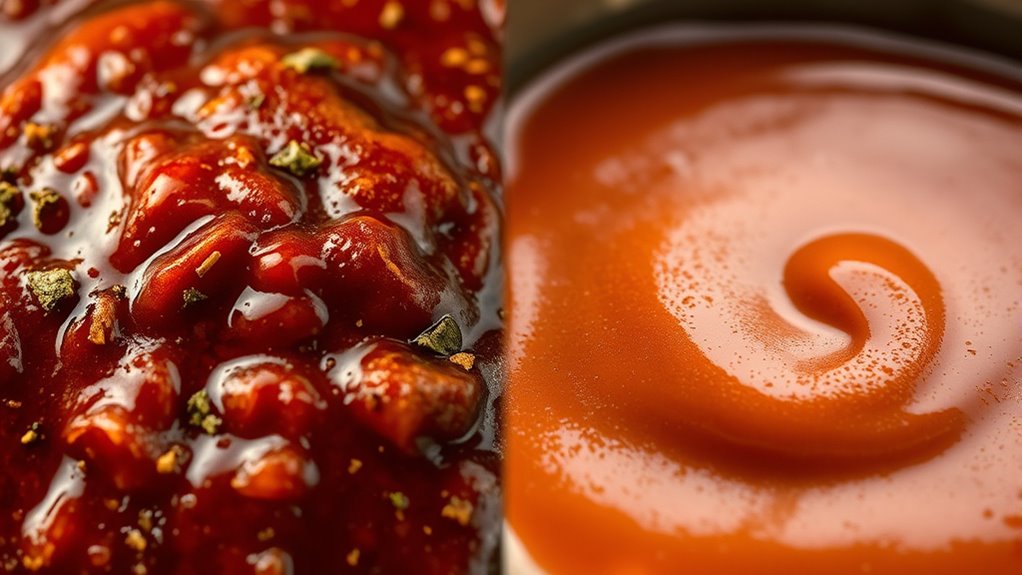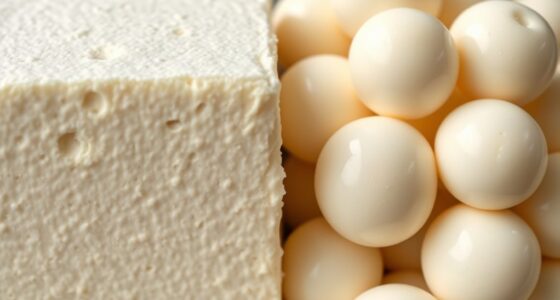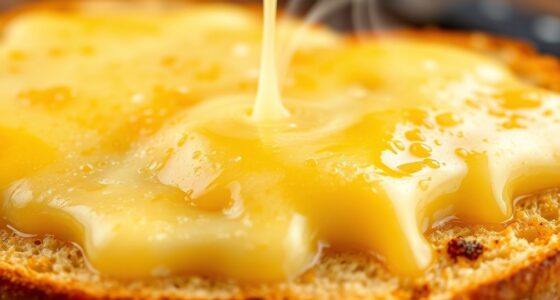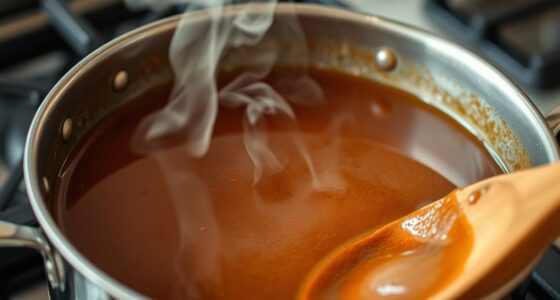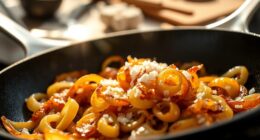Understanding the 12 rules of uncooked versus cooked sauces helps you master flavor, texture, and nutrition. Raw sauces highlight fresh ingredients, bright and sharp, while cooking deepens flavors and softens textures through caramelization and browning. Timing when to cook or keep ingredients raw impacts taste and consistency, with preparation and balancing acidity or sweetness playing key roles. Proper handling guarantees safety and nutrient preservation. Keep exploring to uncover all the secrets behind choosing the perfect sauce for any dish.
Key Takeaways
- Raw sauces preserve fresh, bright flavors and delicate herbs, while cooked sauces develop depth, richness, and complex caramelized notes.
- Cooking alters texture and consistency, thickening or breaking down ingredients, whereas raw sauces maintain a lighter, more vibrant mouthfeel.
- Proper timing and temperature control are essential to prevent overcooking, which can cause graininess or loss of freshness in sauces.
- Raw sauces often require minimal preparation with quick assembly, while cooked sauces benefit from simmering and ingredient integration for flavor development.
- Storage and handling impact flavor preservation; raw sauces are more perishable, while cooked sauces can be stored longer and often have intensified flavors.
Understanding the Flavor Development in Raw vs. Cooked Sauces
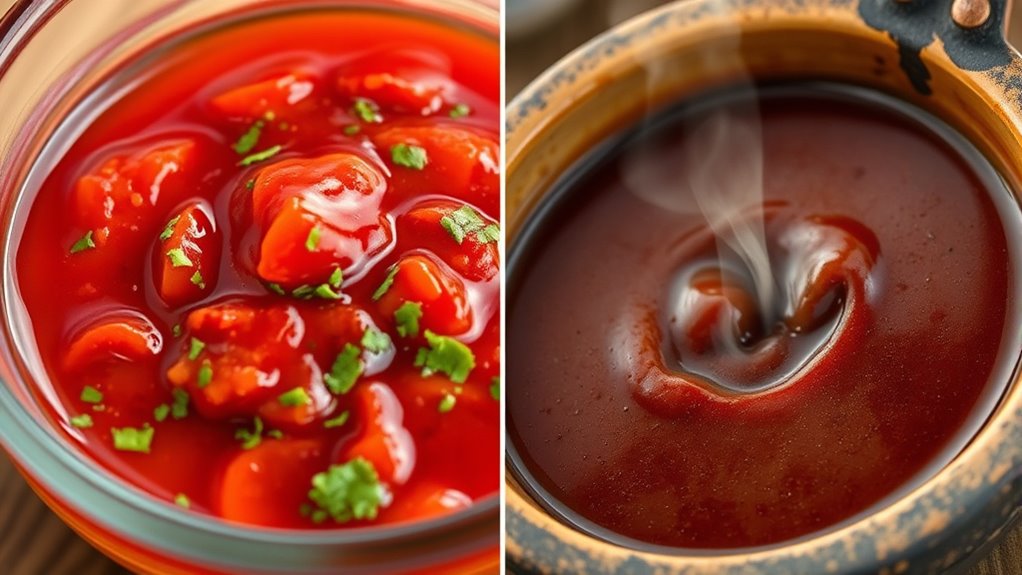
Understanding how flavors develop in raw versus cooked sauces is essential for mastering their unique profiles. When you prepare raw sauces, the focus is on preserving ingredient freshness, which offers vibrant, sharp flavors. Raw sauces often highlight the natural taste of herbs, spices, and fresh produce, providing a clean, bright flavor profile. In contrast, cooking triggers flavor enhancement through chemical reactions like caramelization and Maillard browning, which deepen and complexify tastes. Cooking also softens ingredients, releasing more nuanced flavors. Recognizing these differences helps you decide whether to serve a sauce raw for freshness or cook it to build richness. Both methods influence flavor development, so understanding their impact allows you to craft sauces that perfectly match your desired taste experience.
The Impact of Heat on Texture and Consistency
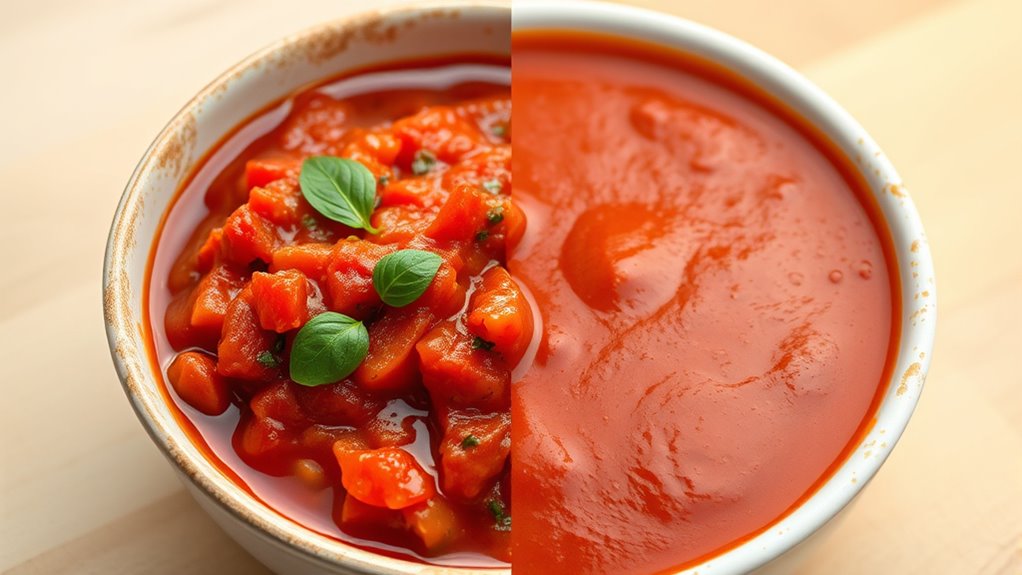
When you apply heat to a sauce, its texture can change considerably. You might notice it thickening or becoming more fluid, depending on how much heat you use. These consistency shifts are key to achieving the perfect sauce for your dish. Additionally, understanding how heat affects fabric textures can help in other contexts, such as caring for farmhouse-style textiles or linens in your decor.
Texture Changes Under Heat
Heat has a profound effect on the texture and consistency of sauces, causing noticeable changes that can alter the final dish. As you heat your sauce, its pH balance shifts, affecting thickening and smoothness. You might notice it becoming thicker or more viscous, or sometimes breaking apart. High heat can tighten the sauce’s structure, but overcooking may lead to a grainy or stringy texture. Additionally, gentle heating preserves aroma and prevents over-reduction, which could lead to a pasty or gluey feel.
- Thickening into a velvety texture
- Breaking or curdling if overheated
- Developing a glossy, smooth finish
- Becoming stringy or grainy
- Losing aroma and freshness
Consistency Variations Occur
As sauces are heated, their consistency can shift dramatically, influencing how they coat dishes and balance flavors. Heat causes ingredients to break down or thicken, affecting the sauce’s texture. Proper ingredient pairing and storage techniques play a key role in maintaining desired consistency. For example, overcooking can make a sauce too thick or grainy, while undercooking might leave it too thin. Adjustments depend on the ingredients used and how you store them beforehand. Here’s a quick comparison:
| Consistency State | Effect of Heat |
|---|---|
| Thin | Perfect for delicate ingredient pairing, like herbs |
| Thick | Ideal for hearty sauces, requires careful storage techniques |
Mastering these variations ensures your sauce’s texture complements your dish perfectly. Additionally, understanding how the storage methods influence ingredient behavior can help you achieve more consistent results.
Thicken or Thin Out
Adjusting a sauce’s thickness is a straightforward process that depends on how you apply heat. When you want to thicken, simmer it gently, allowing moisture to evaporate and concentrate flavors. To thin out, add a splash of liquid—water, broth, or even fruit pairing juices—while stirring. Heat impacts texture considerably; gentle simmering enhances richness, while rapid boiling can break down delicate ingredients. Proper storage techniques help maintain the desired consistency over time, preventing sauces from becoming too thick or watery. Keep in mind that reheating might alter your sauce’s texture, so adjust accordingly. Whether aiming for a silky finish or a pourable consistency, controlling heat and ingredients ensures perfect results every time. Additionally, monitoring the contrast ratio can influence the visual appeal and perceived quality of your sauce, especially when serving in a well-designed presentation.
Timing Is Key: When to Cook or Keep It Raw
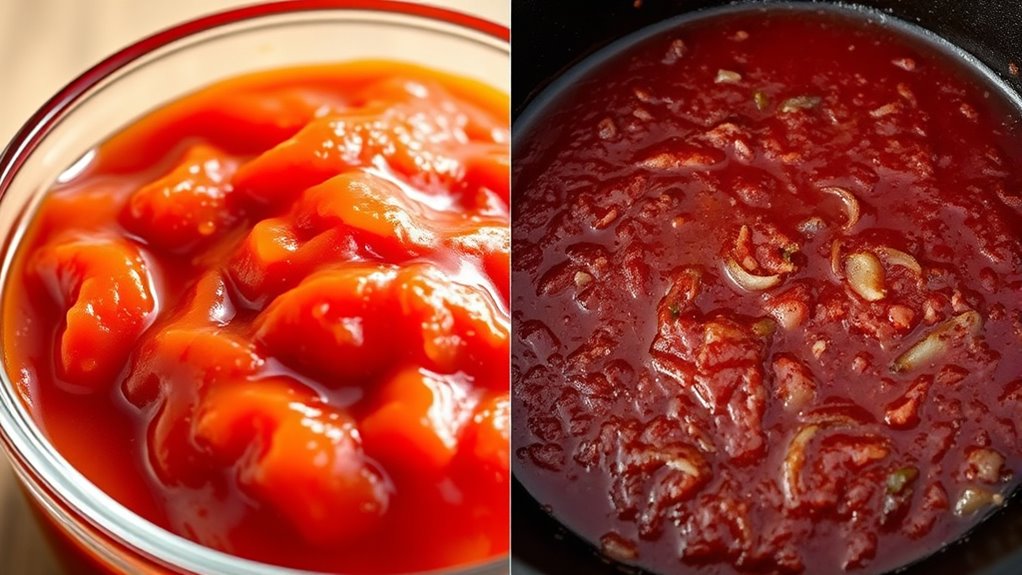
Timing is vital when deciding whether to cook or keep your sauce raw, as it directly impacts flavor, texture, and safety. Knowing when to heat a sauce enhances ingredient pairing, revealing deeper, more complex flavors, or preserves freshness in raw versions. For instance, delicate herbs or bright citrus are best added raw just before serving to maintain vibrancy. Conversely, simmering can meld ingredients and enhance richness. Presentation techniques also influence timing choices; a raw sauce with vibrant raw vegetables looks striking, while a cooked sauce offers a smooth, glossy finish. Additionally, understanding the optimal soil conditions can influence the freshness and quality of ingredients used in sauces, ensuring they retain their best flavor. By understanding when to cook or keep your sauce raw, you guarantee each component shines and the final dish delivers optimal taste and visual appeal. Timing truly makes or breaks the culinary experience.
Ingredient Preparation and Its Effect on Final Taste
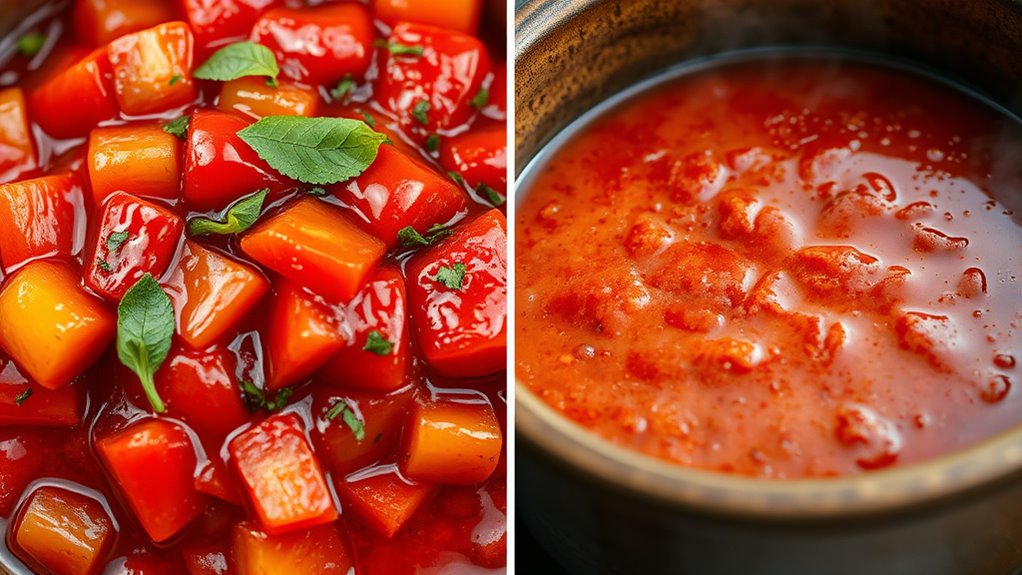
The way you prepare your ingredients considerably influences the final flavor of your sauce. Proper ingredient sourcing guarantees freshness and quality, which directly impacts taste. Your utensil selection also plays a crucial role, affecting texture and consistency. For instance, chopping with a sharp knife creates cleaner cuts, releasing more flavor, while using a blender can create a smoother base. Consider peeling or marinating ingredients to enhance their natural flavors. Toasting spices or roasting vegetables before adding them deepens complexity. Even the size of your cuts matters—smaller pieces blend more thoroughly, releasing more aroma. Paying attention to these details, from sourcing to utensil choice, guarantees your sauce develops a richer, more balanced profile in the final dish. Additionally, understanding the nutritional value of juices can help you choose ingredients that not only enhance flavor but also contribute health benefits.
Balancing Acidity and Sweetness in Different States
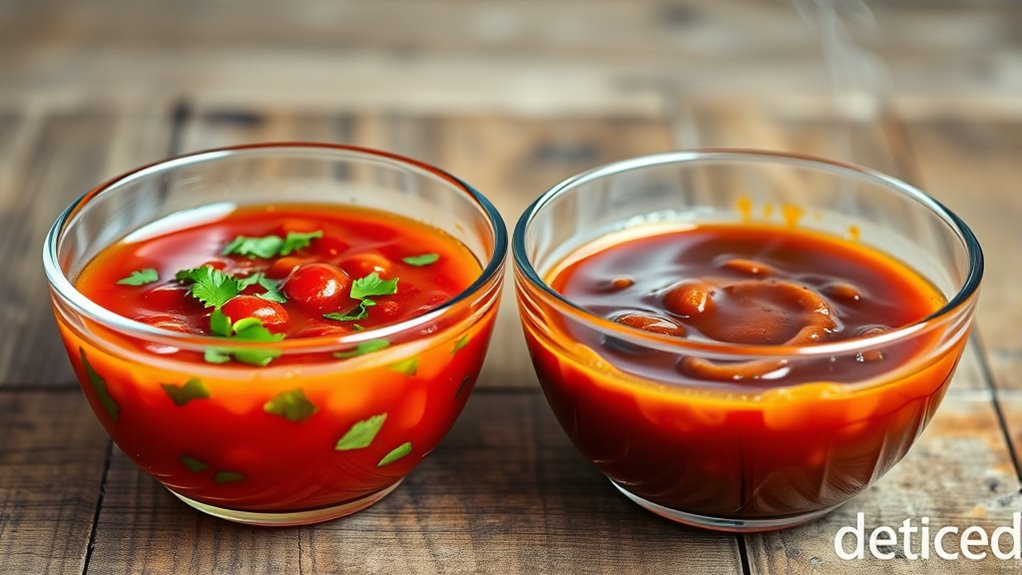
When balancing acidity and sweetness, you’ll notice that fresh flavors tend to be sharper, while cooked sauces mellow with time. You can adjust the acid-base balance using techniques like adding baking soda or vinegar, depending on the desired effect. To fine-tune sweetness, try incorporating sugar, honey, or fruit to achieve a harmonious flavor profile. Additionally, incorporating exfoliating acids like glycolic acid can help improve skin texture, which is an important aspect of overall skin health and appearance.
Fresh vs. Cooked Flavors
Fresh and cooked sauces each deliver distinct flavor profiles, especially when it comes to balancing acidity and sweetness. With raw ingredient freshness, you get vibrant, sharp acidity and bright sweetness that highlight natural flavors. Fresh sauces often have a shorter sauce storage longevity, so they taste best soon after preparation. Cooking, on the other hand, mellows acidity and enhances sweetness through caramelization, creating a richer, more rounded flavor. Cooking also reduces water content, improving sauce stability over time. To visualize:
- Bright, tangy notes from fresh ingredients
- Intensified sweetness after simmering
- Longer shelf life for cooked sauces
- Mellowed acidity in cooked versions
- Preservation of fresh flavors through quick consumption
- Enhanced taste complexity by combining both methods for a well-balanced sauce
Understanding these differences helps you balance flavors effectively, whether you prefer crisp freshness or deep, cooked richness.
Acid-Base Balance Techniques
Balancing acidity and sweetness is key to creating sauces that taste harmonious in both their raw and cooked forms. To achieve this, you can use herb infusion to subtly introduce acidity or sweetness, enhancing the overall flavor layering. When raw, a splash of citrus or vinegar can brighten the sauce, emphasizing freshness. As you cook, flavors mellow and meld, so adjusting acidity becomes more about balancing the richness and depth developed through heat. Incorporate herbs like basil or thyme early in cooking to build complexity, then fine-tune acidity or sweetness at the end. This technique ensures your sauce maintains a pleasing balance whether served raw or cooked, allowing each element to shine without overpowering the other. Additionally, understanding the best anime movies and their storytelling techniques can inspire creative flavor combinations and presentation styles in culinary arts.
Sweetness Adjustment Methods
Adjusting sweetness in your sauce requires different techniques depending on whether it’s raw or cooked. When raw, you can balance acidity with natural sweetness from fruit pairing, adding a touch of honey or maple syrup, or blending spices to enhance flavor complexity. For cooked sauces, simmering naturally mellows acidity, so you might need to add a small amount of sugar or fruit preserves to boost sweetness without overpowering. Use these methods to fine-tune your sauce:
- Incorporate fruit like apples or berries for natural sweetness
- Use honey or maple syrup for quick adjustment
- Blend warm spices to create a balanced flavor profile
- Add a splash of fruit juice to deepen sweetness
- Adjust gradually, tasting as you go for perfect harmony
Adjusting Seasonings for Raw and Cooked Preparations
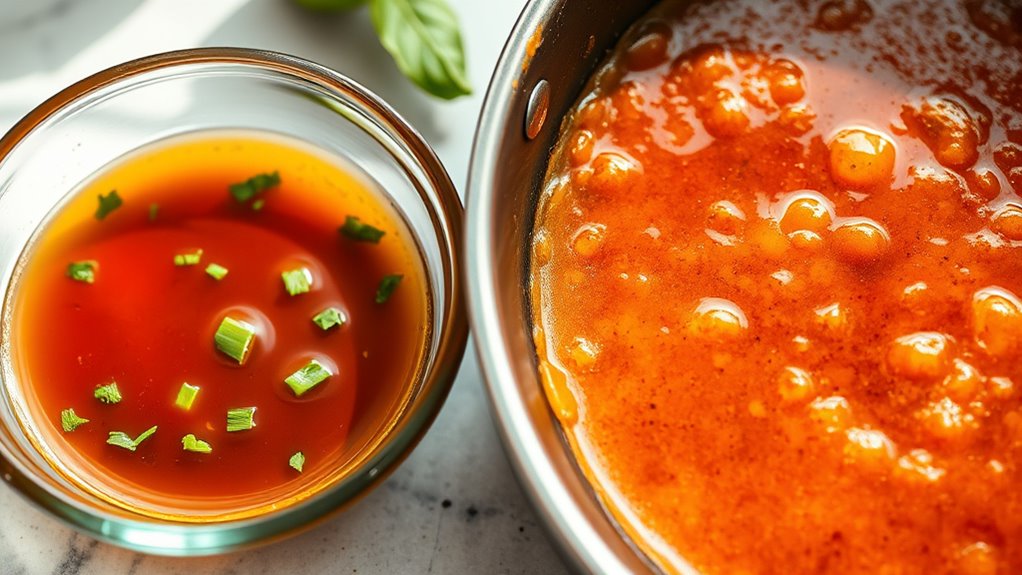
When seasoning raw and cooked sauces, it’s important to recognize that their flavor profiles evolve differently, requiring distinct approaches. Raw sauces benefit from bright, fresh herb pairings that enhance their crispness, so add herbs like cilantro or basil toward the end for a vibrant punch. For cooked sauces, allow the flavors to meld by incorporating herbs earlier in the process, creating a deeper aroma. Spice blending also varies; raw sauces need milder, more delicate spices to preserve freshness, while cooked sauces can handle bolder, ground spices that develop complexity during simmering. Adjust seasoning gradually, tasting frequently to achieve balance. Remember, the goal is to highlight the sauce’s inherent qualities, whether raw or cooked, by tailoring herb pairings and spice blending accordingly.
The Role of Freshness and Storage in Raw Sauces

Freshness is the key to vibrant, flavorful raw sauces, so using high-quality ingredients and proper storage is essential. To guarantee freshness preservation, store ingredients in airtight containers and keep them chilled at consistent temperatures. Use glass jars or BPA-free plastic for better storage techniques, and label everything clearly. Avoid cross-contamination by separating raw ingredients from cooked foods. Regularly check for spoilage, such as discoloration or sour smells, and discard any compromised items. Keep herbs fresh with damp paper towels wrapped in plastic, and consider vacuum sealing for longer storage. Additionally, maintaining proper temperature control is vital to prevent bacterial growth. By prioritizing freshness and employing proper storage techniques, you maximize flavor and safety, ensuring your raw sauces stay vibrant and delicious longer.
How Cooking Alters Color and Visual Appeal
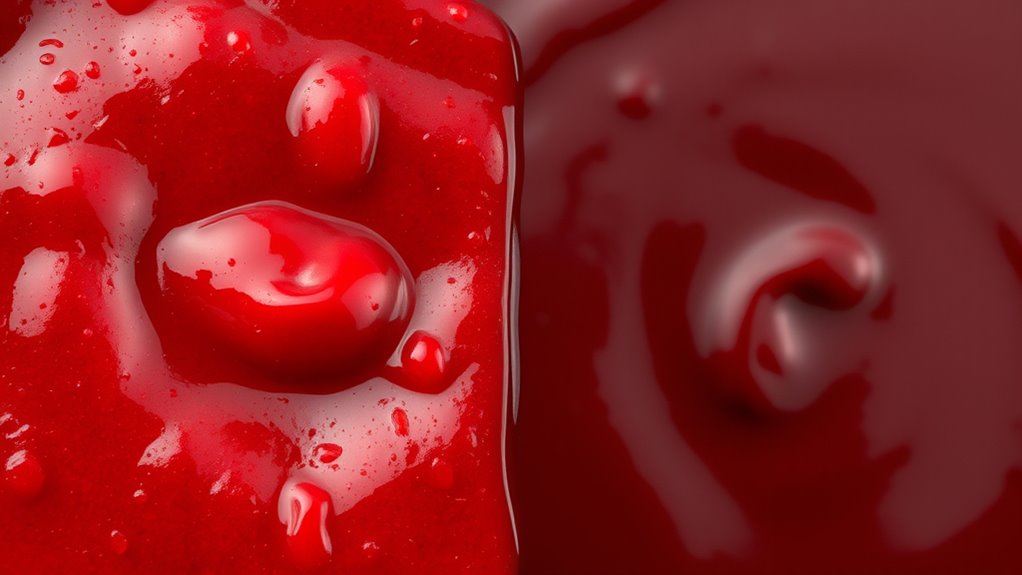
Cooking considerably transforms the color and visual appeal of sauces, making them more appetizing and visually appealing. This process involves a color transformation where raw ingredients develop richer, deeper hues. The heat causes natural sugars to caramelize, intensifying browns and reds, while proteins denature, changing textures and shades. This visual enhancement boosts the sauce’s attractiveness, enticing your senses. Here’s how different sauces change:
| Sauce Type | Raw Appearance | Cooked Appearance |
|---|---|---|
| Tomato Sauce | Bright red | Deep, vibrant red |
| Creamy Alfredo | Pale, dull white | Rich, glossy white |
| Barbecue Sauce | Thin, translucent | Thick, glossy caramel |
Understanding these visual cues helps you judge doneness and appeal, emphasizing how heat elevates sauce aesthetics. Visual transformation is a key indicator of proper cooking and flavor development.
Preserving Nutrients in Uncooked Sauces

To maximize the nutritional benefits of your sauces, it’s vital to handle ingredients with care and use preparation methods that minimize nutrient loss. Fresh, high-quality produce retains more vitamins and antioxidants in uncooked sauces. Incorporate fruit pairing ideas like citrus or berries to boost vitamin C and flavor. Be mindful of cultural variations, as traditional recipes often emphasize raw ingredients to preserve nutrients. Use gentle chopping and avoid prolonged exposure to air and light, which can degrade nutrients. Quick preparation methods help lock in nutrients and preserve vibrant colors. Remember, choosing raw ingredients over cooked ones ensures you get the full spectrum of vitamins, enzymes, and antioxidants, making your sauces both nutritious and delicious.
Handle ingredients gently and use quick, raw methods to preserve nutrients and vibrant flavors.
- Use fresh, organic ingredients when possible
- Store ingredients properly to prevent nutrient degradation
- Incorporate nutrient-rich fruits like citrus or berries
- Minimize exposure to air and light during preparation
- Follow cultural variations that emphasize raw ingredient handling
The Influence of Cooking Methods on Sauce Thickness and Body
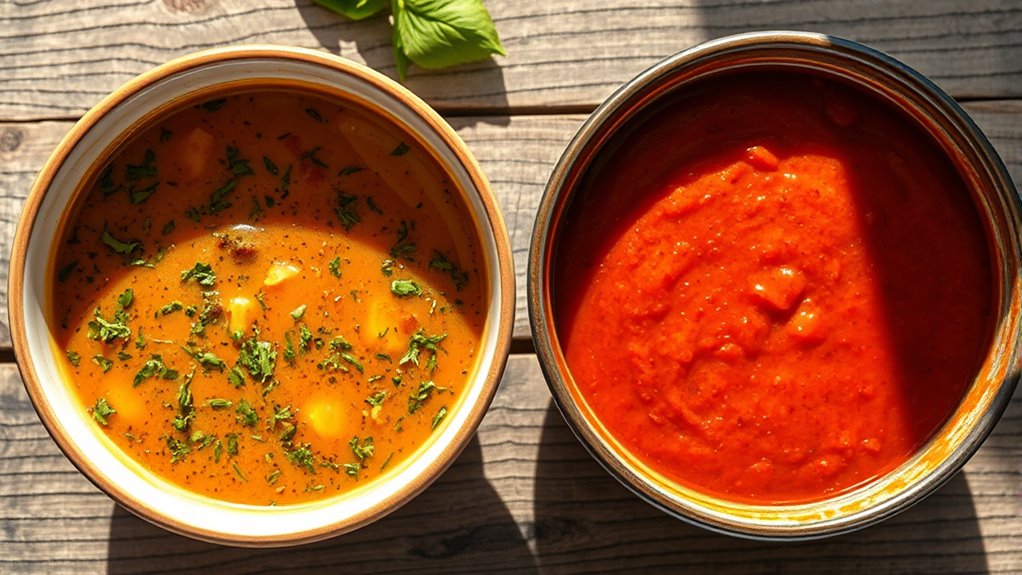
Cooking methods directly impact your sauce’s thickness and body through heat and evaporation, which concentrate flavors and reduce liquid. As you cook, ingredients change in texture and consistency, making the sauce richer or thinner depending on technique. Understanding these effects helps you control the perfect sauce every time.
Heat and Evaporation Effects
When heat is applied to a sauce, it causes water to evaporate, which in turn thickens the mixture and enhances its body. This process intensifies flavors and concentrates ingredients like Herb Infusions, making them more potent. As moisture reduces, oil emulsions become more stable, creating a richer texture. The evaporation also helps reduce acidity or sweetness, balancing the overall flavor profile. Different cooking methods influence evaporation rates: simmering gently retains more moisture, while boiling speeds up thickening. You’ll notice the sauce becomes more viscous, with a concentrated aroma. Be mindful that prolonged heat can lead to over-thickening or burning. Proper control guarantees the sauce gains desired body without losing its delicate nuances and fresh herb notes.
Ingredient Concentration Changes
Different cooking methods directly impact how ingredients concentrate within your sauce, altering its thickness and overall body. As you cook, moisture evaporates, increasing the ingredient concentration, which makes the sauce denser and more robust. Simmering or reducing the sauce intensifies flavor, boosting flavor intensity without adding extra ingredients. Conversely, quick cooking methods preserve more water, leading to a lighter consistency and milder taste. The degree of ingredient concentration depends on cooking time and temperature, shaping the sauce’s texture and richness. By controlling these factors, you influence how thick or thin your sauce becomes and how potent its flavors are. Understanding this relationship helps you tailor the sauce’s body to match your desired outcome, whether it’s a hearty, concentrated finish or a lighter, more delicate result.
Texture and Consistency Shifts
The method you choose to prepare your sauce directly influences its texture and thickness, shaping how it feels on the palate. Cooking triggers texture evolution and affects the consistency dynamics, transforming a thin liquid into a rich, velvety sauce or a thicker, more substantial one. Heat causes moisture evaporation, leading to increased viscosity, while prolonged cooking can break down ingredients, creating smoother textures. Conversely, quick cooking or raw preparations preserve freshness and lighter bodies. These shifts determine whether your sauce coats evenly or remains runny. Understanding these consistency dynamics helps you control the final mouthfeel, tailoring your sauce to suit your dish.
- Thinning out with added liquids
- Thickening via simmering or reduction
- Creamy textures from emulsification
- Chunky consistency from minimal blending
- Smooth, velvety finishes through prolonged simmering
Safety Considerations for Raw Ingredients
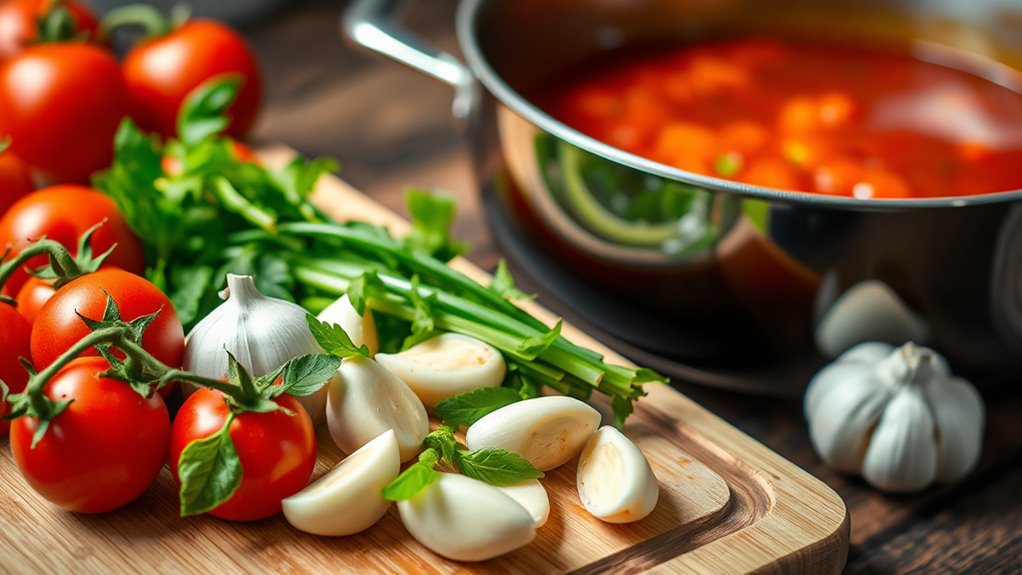
Ensuring the safety of raw ingredients is essential because they can harbor harmful bacteria, parasites, or viruses that cause foodborne illnesses. To minimize risks, follow strict safety protocols and prioritize ingredient sanitation. Always wash produce thoroughly under cold running water and scrub firm-skinned items. Use separate cutting boards for raw proteins and vegetables to prevent cross-contamination.
| Step | Action |
|---|---|
| Washing | Rinse all produce well |
| Cutting | Use dedicated utensils for raw ingredients |
| Storage | Keep raw items refrigerated and separate |
When to Use Raw vs. Cooked Sauces for Maximum Flavor Impact
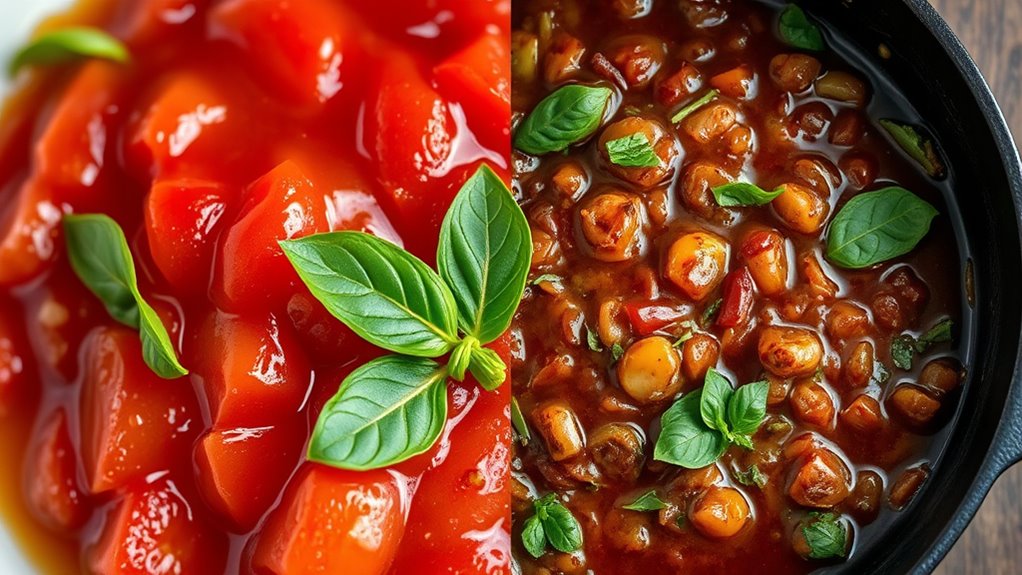
Choosing between raw and cooked sauces depends on the flavor profile you want to achieve. Raw sauces preserve bright, fresh flavors, making them ideal for delicate herb pairings like basil or cilantro, and highlighting regional variations such as Mediterranean or Southeast Asian cuisines. Use raw sauces when you want vibrant, crisp tastes that won’t be muted by heat. Cooked sauces deepen flavors, mellow sharp herb notes, and develop complex profiles through caramelization and reduction.
- Fresh herb accents shine in raw sauces for a lively taste.
- Hearty, savory ingredients benefit from cooking to meld flavors.
- Regional variations influence whether a sauce is better raw or cooked.
- Light, citrusy flavors suit raw preparations.
- Rich, umami components often require cooking for balance.
Frequently Asked Questions
Can Raw Sauces Be Stored Longer Than Cooked Ones?
Raw sauces usually have a longer shelf life than cooked ones because they haven’t been exposed to heat, which can reduce their preservation. You can store raw sauces for several days to a week if kept in airtight containers in the fridge. To extend their shelf life, use preservation methods like adding vinegar or freezing. Cooked sauces, on the other hand, typically last only 3 to 5 days.
How Do Raw and Cooked Sauces Differ Nutritionally?
Think of raw sauces as fresh paintings, bursting with vibrant nutrients, while cooked sauces are like layered murals, their nutritional content altered by heat. Raw sauces preserve more vitamins and enzymes, offering higher nutritional value, but spoil faster. Cooked sauces may lose some nutrients during heating, yet they benefit from preservation methods like cooking, which extend shelf life. Your choice depends on balancing nutrition with storage and flavor preferences.
Are There Specific Dishes Better Suited for Raw or Cooked Sauces?
You’ll find that certain dishes are better suited for raw or cooked sauces based on ingredient pairing and culinary traditions. For instance, fresh salads and seafood often benefit from raw sauces that preserve delicate flavors, while hearty pasta or grilled meats usually pair well with cooked sauces that add richness. By understanding these traditions, you can enhance your dishes’ taste and texture, making your culinary creations more authentic and satisfying.
What Are Common Safety Risks With Raw Sauce Ingredients?
You should be aware that raw sauce ingredients pose safety risks like bacterial growth and cross-contamination. To avoid these, always wash your hands and utensils thoroughly, keep raw ingredients separate from cooked foods, and refrigerate promptly. Bacteria can multiply quickly at room temperature, increasing the risk of foodborne illnesses. Staying vigilant with hygiene and proper storage protects you from these common risks associated with raw sauce ingredients.
How Does Personal Taste Influence Choosing Raw Versus Cooked Sauces?
You might think your taste is simple, but it actually guides whether you prefer raw or cooked sauces. Ironically, your flavor preferences and texture considerations shape your choice more than safety or tradition. If you love fresh, vibrant flavors and a crisp texture, raw sauces are your go-to. But if you crave richness and depth, cooking develops those flavors, making cooked sauces irresistible. Your personal taste determines the sauce style you’ll enjoy most.
Conclusion
Mastering raw versus cooked sauces is like dancing with fire—you need to know when to step in and when to let it breathe. By understanding these 12 rules, you’ll discover flavors that sing and textures that delight. Think of it as a culinary symphony where timing and technique are your conductors. So, trust your palate, balance your ingredients, and let your sauces tell their delicious story. Your taste buds will thank you for the show.
